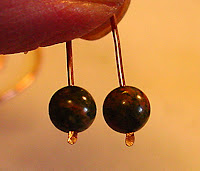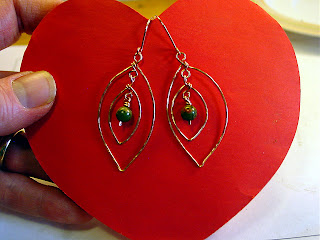Got another wirework tutorial for you- this one doesn't take much wire, and requires only minimal skills- it's pretty forgiving, thanks to the use of hammers. (Yeah, I really do have a thing for hammering!) These earrings are very kinetic- lots of movement, and any color of wire will do.
Get your tools and wire ready- these are fast, fun, and easy!
To make this project, you're going to need-
Tools:
Flush cutters or wire nippers
Nylon jawed pliers
Flat chain nose pliers
Round nose pliers
Needle files
Bent nose pliers (optional, but they do make things easier)
Needle nose pliers without teeth (optional)
Anvil or bench block
Ball peen hammer
Wire:
2- 5" lengths of 18 or 20 gauge wire (for large leaves)
2- 3 1/4" lengths 20 gauge wire (for small leaves)
2- 1" lengths 20 gauge wire (for bead pins)
2- 1 3/4" or 2" lengths 20 gauge wire (for earwires- smaller for the simple wire, longer for beaded earwires)
Plus:
2- 1/4"-3/8" beads
2- 4mm or smaller coordinating beads for earwires, if using
Let's get started!


First, make a "P" loop on one end of the 5" wire- grab the tail-end of the wire with your chain nose pliers to start it, then use your round nose pliers to continue the loop. (This makes the curl tidier and rounder, where it will meet the main wire.) Don't center it.
Next, measure 2" from the neck of the loop- this is where you're going to make a sharp "V". I'd highly recommend crimping your V from both sides of the wire- for some reason, this always makes a cleaner bend, and holds shape better when you're doing the rest of the shaping.
Shape a curve in the looped side of the wire with your fingers. Then shape a matching curve in the other side, leaving the end mostly straight.
Measure about about 7/8" from the unlooped end, and bend the wire around the frame, just below the looped end. Make 2 wraps around the body of the leaf, and pull the wire end towards the center of the top of the leaf.
It's time to make a hanging loop for your next leaf- use your round nosed pliers to roll a loop up with that wire end.
Nip off any excess wire, and tidy up your leaf.
Now repeat the process, and make a second one. You might want to create your wraps in the opposite direction to the first- I'd recommend doing so with your second set of leaves, too, so that you have a symmetrical pair.
For the smaller set of leaves- the only differences are the set of the top loop, and the measurements.
So, take a 3 1/4" length of 20 gauge, and make a centered loop, like so:
Cant the loop to one side, at about a 45 degree angle to the main body of the wire, so that it looks like this:
Measure out 1" down the wire from the neck of the loop- this is where you'll make your V. Proceed as you did with the larger leaves, but measure your tail end at about 3/4" from the end. Make your centered loop inside of the leaf just like before. Lay them out and have a look at the shapes and the directions of the wraps, and make adjustments as needed. Look good? (Ha, you can see, on the right, where I didn't crimp the V on both sides, in the small leaf. Makes a difference, doesn't it?)
Ok, hammer 'em! I used a ball peen hammer's rounded end, because frankly, you can hide a lot of wireworking sins with hammering. (I tend to gouge wires, make imperfect shapes, etc. It's OK. I can live with that. Because I have hammers.) When hammering these, avoid the necks of your wraps, but do hammer the sides and bottom V's. I also tapped the loops, using the little peg-thingy on my anvil, to help disguise the marks that I made with the round nosed pliers (I grabbed the wires too tight!), and to strengthen them.
Now you have a pile of beaten, fallen leaves! Don't they look nicer?
Tidy them up with your nylon jaw pliers, so your pretty hammer marks don't get marred. You can also give them a slight curve, if you wish- I bowed mine slightly, so that the facing sides rounded outwards just a bit. This is also a good time to straighten up your top loops, etc. With the nylon jaws, you can crimp them down nice and neat, so the loops are flat to the rest of the leaf, with no worries!
Now you're going to attach them to each other. Here's a tip that will serve you well with any jewelry-making- open the hanging loops on your large leaves just as you would a jump ring. When opening a jump ring, you never pull it open- you push it open sideways, while holding it with two pairs of pliers, and close it the same way. In this case, you won't need two sets of pliers, but you're going to twist the loops open, and then closed again, after adding your little leaves. Like this:
Perfect. Now, check that your chosen beads will have room to hang on their pins, inside of the small leaves....
Plenty o' room!
Now we'll make hammered spade pins with those 1" lengths of wire.
Take a wire piece, and hammer it with the round end of the hammer, about 1/4" from the end. Hammer the second piece exactly the same.
You'll have two funny-looking pieces of wire, but that's OK.
Test your beads on them- do they fit about the same? Does the spaded end hold them on at about the same spot? Excellent.
Use a needle file to round out the hammered end, so that no one cuts themselves on it!
Now make either a simple loop, or a wrapped loop, to complete your bead dangles. Because these unakite lovelies were only 1/4" long, I used the wrapped loop technique. Take your flat chain nose pliers, and cock the wire over sharply...
Swap over to your round nosed pliers, and start your loop....
Change your plier's position as often as needed- it's not a race.
When the loop's complete, wrap the wire end around the neck of the loop a couple of times, and clip the excess.
Now, repeat the steps that you took to attach your bead dangle to your inner leaf:
Done! Last step- the earwires. I'll demonstrate the simple ones, and give instructions for the beaded version.
Grab your 1 3/4" wire pieces and a small-barreled pen or mechanical pencil- anything round will do...
Curl the wire around the barrel of the pencil, like so. Make sure that you have 3/8" longer on one side than the other. This is where your hanging loop will be.

Using your round nose pliers, roll that loop right up, so that the neck is right about at the same length as the other end.
Using your chain nose pliers, give the pointy end a little swoop outward- this'll make it a lot easier to put them in your ears!
And finally, do NOT forget to file that end to an ear-friendly roundedness!
You can hammer them a bit, to help them retain their shape, and attach them to your leaves.
What's that you say? You'd like to know about the alternative wires?
 |
| Silver Swingin' Leaves with Beaded Earwires |
Alrighty!
Instead of the 1 3/4" wires, cut yourself some 2" pieces, and grab some 24 or 28 gauge wire, plus your little beads. Instead of curling the wires first, make your loop, then slide the bead down, THEN curl the wires around the pen. Shape the business end of the earwire with the pliers, just like last time, but after that, gently hammer your wires with a flat hammer, avoiding the bead like the plague. Wrap the looped side of the wire tightly with the smaller gauge wire, tuck in the ends, and viola! Beaded earwires!
Oh, and file 'em. Don't forget to file 'em!
Both versions look great, though- with the copper ones, I wanted the unakite beads to really pop- sadly, my camera and lighting disagreed with me. (They're MUCH prettier in person!)
And the crackle-glass ones remind me of an off-color peacock's feathers. I used simple headpins on these beads, and spiraled the wire from the wrapped loops around, to make faux bead caps, on the tops.
Hope you've enjoyed the tutorial- the originals pictured here will be available on Uniting a Family as one-time offers, so if you're feelin' lazy but want a pair, and you want to help a good cause, pop over there and get 'em! (You can read about our fund drive here. The backstory can be found here.)
There will be more to come!
~
Linking up to Craft-O-Maniac Monday, and AllFreeJewelryMaking.com! See ya there!








































they are so lovely!! i think i am gonna try it one day <3
ReplyDeleteThese earrings are lovely, i am really going to give them a try.
ReplyDeleteToo much fun! I love these earrings. I am hoping somewhere, in my bead stash that I can find some rainbow colored beads similar to the one's that you used. Very lively!
ReplyDeleteI would love to make these beautiful and very classy earrings. I will have to see if I have the right wire guage in my stash. Wire has gotten expensive for some with a fixed income. But I am going to make these fun loving earrings for myself. Thank you for sharing this pattern with us.
ReplyDeleteThanks, guys! And Sarah: one of the great things about this design is how little wire it actually uses, as compared to, say, something with a lot of scrollwork or wrapping- you can even use the craft wire that Walmart carries for this project. I also discovered yesterday that Ace Hardware has 25' rolls of 18-gauge copper wire for under $4. I was kinda excited about that, because all of the craft-type wires are coated or treated with non-tarnish stuff, but this roll is untreated- I'll finally be able to do some egg patina work! :D I'll try to get a tute up about that soon. Thanks again, everyone!
DeleteThese are lovely and doable. I am relatively new to wire work and hope to try these soon. The directions are excellent. Do you have any video tutorials.
ReplyDeleteWelcome to the wonderful world of wirework, Tapestrygal! (Ha ha, say *that* five times really fast! LOL) Thank you so much for the compliments! I don't have any videos made as yet, but had been toying with the idea- finding a cameraman is the challenge. Happy wireworking!
DeleteAwesome, I will definitely try these. Thanks for sharing these and your instructions will be so easy to follow, since I'm new to wireworking.
ReplyDeleteI hope you have fun with 'em- they're so easy to change up. :)
DeleteAhaa, its pleasant conversation regarding this paragraph here at this blog,
ReplyDeleteI have read all that, so at this time me also commenting at this place.
Utterly indited subject material, Really enjoyed looking at.
ReplyDelete